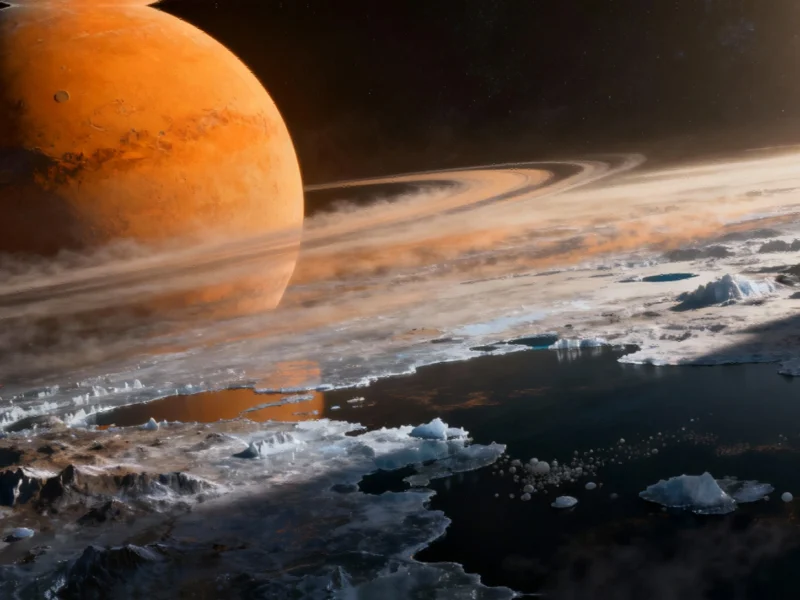Groundbreaking Discovery Rewrites Chemical Possibilities on Alien Worlds
In a stunning revelation that challenges long-held scientific principles, researchers from Chalmers University of Technology and NASA have uncovered chemical behavior on Saturn’s moon Titan that defies one of chemistry’s most fundamental rules. This paradigm-shifting discovery reveals that in Titan’s extreme cold, substances that should remain separate can actually combine, opening new possibilities for understanding chemical processes that preceded life’s emergence. The findings, detailed in a recent PNAS publication, demonstrate how this chemical anomaly on Titan could reshape our understanding of prebiotic chemistry throughout the universe.
Titan’s Unique Environment: A Window to Early Earth
Scientists have long been fascinated by Titan, Saturn’s largest moon, which presents an orange-hued world with conditions remarkably similar to what early Earth might have experienced billions of years ago. With its thick nitrogen and methane atmosphere and extremely cold temperatures averaging around -180°C, Titan serves as a natural laboratory for studying the chemical steps that might lead to life. “These findings help us understand something on a very large scale, a moon as big as the planet Mercury,” explains Martin Rahm, Associate Professor at Chalmers and lead researcher on the study.
The Impossible Mixture: Polar and Nonpolar Substances Combine
The research team made their unexpected discovery while investigating how hydrogen cyanide behaves after forming in Titan’s atmosphere. Through experiments conducted at NASA’s Jet Propulsion Laboratory, scientists mixed hydrogen cyanide crystals with liquid methane and ethane at Titan-like temperatures. Using laser spectroscopy to examine the molecular interactions, they observed something previously thought impossible: the polar hydrogen cyanide molecules were forming stable structures with completely nonpolar methane and ethane.
“This contradicts the fundamental chemistry rule of ‘like dissolves like,’ which basically means these substances should remain separate, much like oil and water,” says Rahm. The discovery came through an intensive collaboration between Chalmers researchers, who conducted extensive computer simulations, and NASA’s experimental team. Their analysis revealed that hydrocarbons had penetrated hydrogen cyanide’s crystal lattice, forming stable new structures called co-crystals.
Implications for Prebiotic Chemistry and Life’s Building Blocks
The implications of this discovery extend far beyond Titan’s mysterious landscape of lakes, seas, and sand dunes. Hydrogen cyanide plays a crucial role in the abiotic creation of life’s fundamental components, including amino acids for protein construction and nucleobases needed for genetic coding. “Our work contributes insights into chemistry before the emergence of life, and how it might proceed in extreme, inhospitable environments,” Rahm emphasizes.
This research comes at a time when scientific advancements across multiple fields are reshaping our understanding of biological and chemical processes. The Titan discovery demonstrates how extreme environments can foster chemical interactions that challenge our Earth-centric understanding of molecular behavior.
Future Exploration and Universal Applications
NASA’s Dragonfly mission, scheduled to launch in 2028 and reach Titan in 2034, will build upon these findings by directly investigating the moon’s surface chemistry. Until then, Rahm and his colleagues plan to continue exploring hydrogen cyanide chemistry in collaboration with NASA. The research has broader implications for understanding chemical processes in other cold space environments, from planetary atmospheres to comets and interstellar dust clouds.
As scientific institutions worldwide continue to push boundaries in exploration and discovery, the Titan findings represent a significant step in understanding how life might emerge under conditions very different from those on Earth. “We may be able to find out if other nonpolar molecules can also enter hydrogen cyanide crystals and what this might mean for the chemistry preceding the emergence of life,” Rahm concludes, highlighting the ongoing nature of this revolutionary research.
The discovery not only expands our knowledge of Titan’s chemical environment but also challenges scientists to reconsider fundamental chemical principles when applied to extreme conditions found throughout the universe.
Based on reporting by {‘uri’: ‘phys.org’, ‘dataType’: ‘news’, ‘title’: ‘Phys.org’, ‘description’: ‘Phys.org internet news portal provides the latest news on science including: Physics, Space Science, Earth Science, Health and Medicine’, ‘location’: {‘type’: ‘place’, ‘geoNamesId’: ‘3042237’, ‘label’: {‘eng’: ‘Douglas, Isle of Man’}, ‘population’: 26218, ‘lat’: 54.15, ‘long’: -4.48333, ‘country’: {‘type’: ‘country’, ‘geoNamesId’: ‘3042225’, ‘label’: {‘eng’: ‘Isle of Man’}, ‘population’: 75049, ‘lat’: 54.25, ‘long’: -4.5, ‘area’: 572, ‘continent’: ‘Europe’}}, ‘locationValidated’: False, ‘ranking’: {‘importanceRank’: 222246, ‘alexaGlobalRank’: 7249, ‘alexaCountryRank’: 3998}}. This article aggregates information from publicly available sources. All trademarks and copyrights belong to their respective owners.

